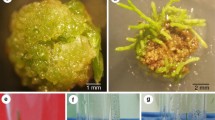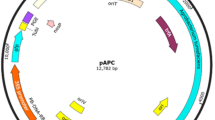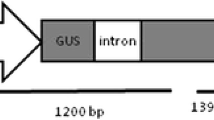Abstract
An originalAgrobacterium tumefaciens-mediated transformation procedure, based on the actions of both wild type and disarmed bacterial strains, was developed. Theaux2 gene ofA. rhizogenes was introduced into a rapid-cycling genotype of cabbage (Brassica oleracea L.). Theaux2 gene product converts naphthalene acetamide into the auxin naphthalene acetic acid. Expression of this gene in the transgenic progeny grownin vitro led to an altered root phenotype. On a medium supplemented with napthalene acetamide (NAM), two of the three analysed progenies were characterized by the formation of callus instead of roots, whereas on a NAM-free medium all the plantlets from these progenies presented a normal phenotype. Expression of theaux2 gene was also assessed under horticultural conditions by sowing seeds in sand and watering them with a nutritive solution supplemented with NAM. Under these conditions, NAM inhibited the formation of a root system in transgenic plantlets and induced the death of the transgenic plantlets three to four weeks after germination. Thus,aux2 acts as a lethal conditional marker which could be used in negative selection of cabbage. Potential utilization of theaux2 gene to screen spontaneous androgenetic plants in order to transfer cytoplasmic male sterility in a single generation is discussed.
Similar content being viewed by others
References
Bannerot, H. and Boulidard, L. (1974) Transfer of cytoplasmic male sterility fromRaphanus sativus toBrassica oleracea. InProceedings of the Eucarpia Meeting on Cruciferae, Scottish Horticultural Research Institute, Invergourie, Dundee, pp. 52–5.
Boyer, H.W. and Rolland-Dussoix, D. (1969) A complementation analysis of the restriction and modification of DNA inEscherichia coli.J. Mol. Biol.,41, 459–72.
Brasileiro, A. C. M., Leplé, J. C., Muzzin, J., Ounnough, D., Michel, M. F. and Jouanin, L. (1991) An alternative approach for gene transfer in trees using wild-typeAgrobacterium strains.Plant. Mol. Biol.,17, 441–52.
Braun, A. C. (1948) Studies on the origin and development of plant teratomas incited by the crown gall bacterium.Amer. J. Bot.,35, 511–9.
Budar, F., Deboeck, F., Van Montagu, M. and Hernalsteens, J. P. (1986) Introduction and expression of the octopine T-DNA oncogenes in tobacco plants and their progeny.Plant Sci.,46, 195–206.
Burk, L. G. (1962) Haploids in genetically marked progenies of tobacco.J. Hered.,53, 222–5.
Camilleri, C. and Jouanin, L. (1991) The TR-DNA region carrying the auxin synthesis genes of theAgrobacterium rhizogenes agropine-type plasmid pRiA4: nucleotide sequence analysis and introduction into tobacco plants.Mol. Plant-Microbe Interact.,4, 155–162.
Chase, S.S. (1963) Androgenesis—its use for transfer of maize cytoplasm.J. Hered. 54, 152–8.
Chase, S. S. (1960) Monoploids and monoploid-derivatives of maize (Zea mays L.).Bot. Rev.,35, 117–67.
Coïc, Y. and Lesaint, C. (1961) Comment assurer une bonne nutrition en eau et ions minéraux en horticulture.Hortic. Fr.,8, 11–14.
Dellaporta, S. L., Wood, J., and Hicks, J. B. (1983) A plant DNA minipreparation: versin II.Plant Mol. Biol. Rep.,1, 19–21.
Deroles, S. C. and Gardner, R. C. (1988) Analysis of the T-DNA structure in a large number of transgenic petunias generated byAgrobacterium-mediated transformation.Plant Mol. Biol.,11, 365–77.
Doré, C. (1975) La multiplication clonale de l'asperge (Asparagus officinalis) par culturein vitro: son utilisation en sélection.Ann. Amélior. Plantes,25, 201–24.
Doré, C. and Boulidard, L. (1988) Production de plantes androgénétiques de chou à choucroute (Brassica oleracea L. ssp.capitata) par culture d'anthèresin vitro: comportement des lignées haploïdes doublées (HD) et leur intérêt comme parents d'hybrides F1.Agronomie,8, 851–62.
Hoekema, A., Hirsch, P. R., Hooykaas, P. J. J. and Schilperoot, R. A. (1983) A binary plant vector strategy based on separation of vir- and T-region of theAgrobacterium tumefaciens Ti-plasmid.Nature,303, 179–80.
Holsters, M., de Waele, D., Depicker, A., Messens, E., Van Montagu, M. and Schell, J. (1978) Transfection and transformation ofAgrobacterium tumefaciens.Mol. Gen. Genet.,163, 181–7.
Horlow, C. (1991) Création de lignées de tabac mâle stériles cytoplasmiques par androgenèsein situ. Thèse de doctorat, Université de Paris-Sud, Centre d'Orsay, France.
Inzé, D., Follin, A., van Lijsebettens, M., Simoens, C., Genetello, C., Van Montagu, M. and Schell, J. (1984) Genetic analysis of the individual T-DNA genes ofAgrobacterium tumefaciens: further evidence that two genes are involved in indole-3-acetic acid synthesis.Mol. Gen. Genet.,194, 265–74.
Jefferson, R. A., Kavanagh, T. A. and Bevan, M. W. (1987) GUS fusions: β-glucuronidase as a sensitive and versatile gene fusion marker in higher plants.EMBO J.,6, 3901–7.
Jones, J. D. G., Gilbert, D. E., Grady, K. L., and Jorgensen, R. A. (1987) T-DNA structure and gene expression in petunia plants transformed byAgrobacterium tumefaciens C58 derivatives.Mol. Gen. Genet.,207, 478–85.
Jorgensen, R., Snyder, C. and Jones, J. D. G. (1987) T-DNA is organized predominantly in inverted repeat structures in plants transformed withAgrobacterium tumefaciens C58 derivatives.Mol. Gen. Genet.,207, 471–7.
Karlin-Neumann, G. A., Brusslan, J. A., and Tobin, E. M. (1991) Phytochrome control of thetms2 gene in transgenicArabidopsis: A strategy for selecting mutants in the signal transduction pathway.The Plant Cell,3, 573–82.
Koncz, C. and Schell, J. (1986) The promoter of TL-DNA gene 5 controls the tissue-specific expression of chimaeric genes carried by a novel type ofAgrobacterium binary vector.Mol. Gen. Genet.,204, 383–96.
Maniatis, T., Fritsch, E. F., and Sambrook J. (1982)Molecular Cloning: a Laboratory Manual. Cold Spring Harbor, NY. USA: Cold Spring Harbor Laboratory Press.
Michel, M. F., Brasileiro, A. C. M., Depierreux, C., Otten, L., Delmotte, F. and Jouanin, L. (1990) Identification of differentAgrobacterium strains isolated from the same forest nursery.Appl. Environ. Microbiol.,56, 3537–45.
Miller, J. H. (1972)Experiments in Molecular Genetics. Cold Spring Harbor, NY, USA: Cold Spring Harbor Laboratory Press.
Murashige, T. and Skoog, F. (1962) A revised medium for rapid growth and bioassays with tobacco tissue culture.Physiologia Plantarum,15, 473–97.
Offringa, I. A., Melchers, L. S., Regensburg-Tuink, A. J. G., Costantino, P., Schilperoort, R. A. and Hooykaas, P. J. J. (1986) Complementation ofAgrobacterium tumefaciens tumor-inducing aux mutants by genes from the TR-region of the Ri plasmid ofAgrobacterium rhizogenes.Proc. Natl Acad. Sci., USA,83, 6935–9.
Pelletier, G., Ferault, M., Goujaud, J., Vedel, F. and Caboche, M. (1987) The use of rootless mutants for the screening of spontaneous androgenetic and gynogenetic haploids inNicotiana tabacum: evidence for the direct transfer of cytoplasm.Theor. Appl. Genet. 75, 13–5.
Pelletier, G., Férault, M., Lancelin, D. and Boulidard, L. (1989) c.m.s.Brassica oleracea cybrids and their potential for hybrid seed production. InScience for Plant Breeding (book of poster abstracts, part I). Proc 12th Cong Eucarpia. Göttingen Germany, Feb 27th-March 4th, pp. 11–7.
Schröder, G., Waffenschmidt, S., Weiler, E. W. and Schröder, J. (1984) The T-region of Ti plasmids codes for an enzyme synthesizing indole-3-acetic acid.Eur. J. Biochem.,138, 387–91.
Tepfer, M. and Casse-Delbart, F. (1987)Agrobacterium rhizogenes as a vector for transforming higher plants.Microbiol. Sci.,4, 24–8.
Thomashow, M. F., Hungly, S., Buchholz, W. G. and Thomashow, L. S. (1986) Molecular basis for the auxin-independent phenotype of crown gall tumour tissues.Science,231, 616–8.
Thompson, K. F. (1956) Production of haploid plants of marrowstem kale.Nature,178, 748.
While, F. F., Taylor, B. H., Huffman, G. A., Gordon, M. P. and Nester, E. W. (1985) Molecular and genetic analysis of the transferred DNA regions of the root-inducing plasmid ofAgrobacterium rhizogenes.J. Bacteriol.,164, 33–44.
Williams, P. (1985)Crucifer Genetics Cooperative Resource Book., Univ. of Wisconsin, USA.
Author information
Authors and Affiliations
Rights and permissions
About this article
Cite this article
Béclin, C., Charlot, F., Botton, E. et al. Potential use of theaux2 gene fromAgrobacterium rhizogenes as a conditional negative marker in transgenic cabbage. Transgenic Research 2, 48–55 (1993). https://doi.org/10.1007/BF01977680
Received:
Revised:
Accepted:
Issue Date:
DOI: https://doi.org/10.1007/BF01977680




